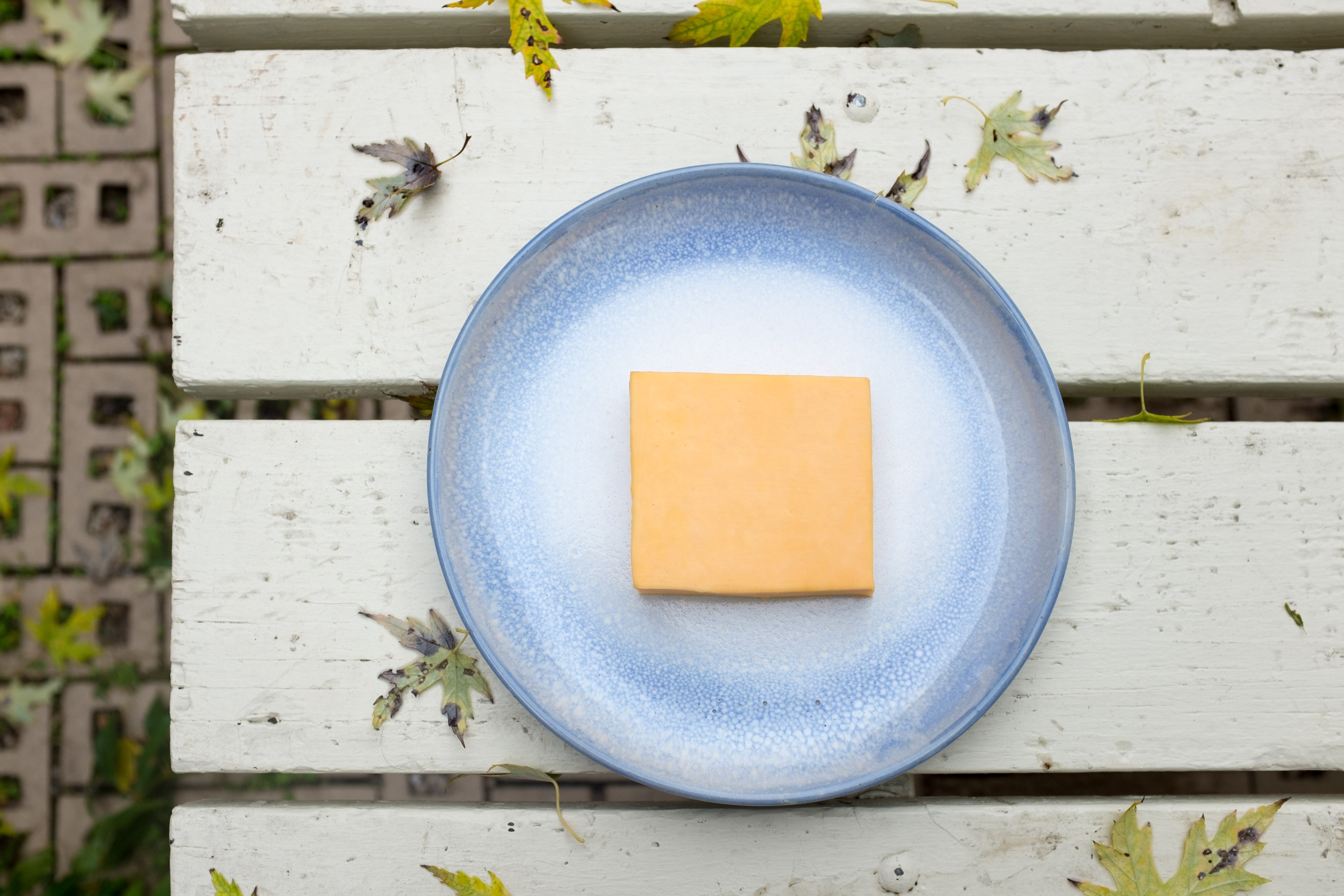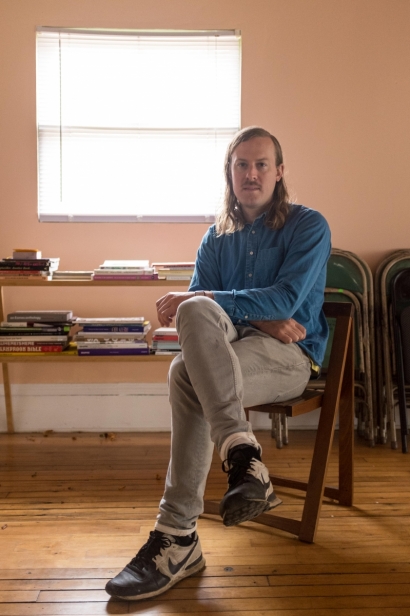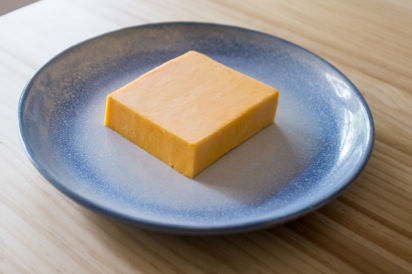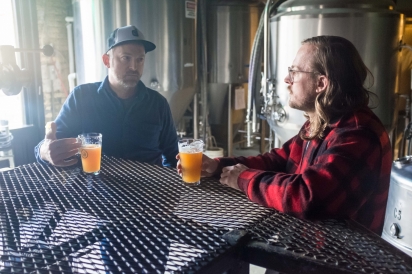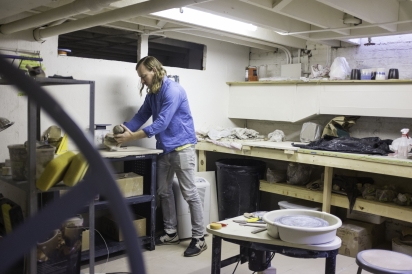Transforming Cultures
Over the years, John Riepenhoff and I would meet now and then at our local meeting spot to talk about art, life and other subjects. When we both lived in Milwaukee, our meeting spot was usually a bar — the old Falcon Bowl on a quaint Riverwest street corner across from a little independent co-op grocery.
We’d been patronizing the “Polish Falcons” (as the sign reads) for years — for beer, bowling and conversation. Once we turned it briefly into an international art world hub, without hardly changing it a bit.
The only thing that perplexed Falcon Bowl owners John and Lynn Okopinski about the first Milwaukee International Art Fair — which ran for a weekend in 2006— were the high prices on the art from China, Japan, Puerto Rico, Cuba, Canada, Chicago, New York and other locales.
But they did a steady business at the bar, and we cleared out in time for the noon Sunday Halloween party for the neighborhood kids. And we did it all without scratching the Polish Turner’s hardwood beer hall gym floor.
At the Falcon, our usual choice of beer was — since its beginning in 1987— Lakefront. It was made less than a mile away and the brewery’s’ founders Russ and Jim Klisch occasionally stopped in to sample their wares.
For the brothers Klisch, an interest in beer had become their life’s work, not unlike Riepenhoff and his artist friends.
For instance, for a local role model like Michelle Grabner — an artist and curator admired for her legendary balancing of wage-earning, motherhood, artistry, gallery management, critical writing and other pursuits — the age-old idea of a boundary between life and art seemed like an old-fashioned, almost useless way to think.
If life and art — like life and any other line of work— became effectively combined, a life’s passion became a way of living.
One night, Riepenhoff coined a term to describe such melding — “Behavior Art.” In the pantheon of art types, from Impressionism to Pop Art to Performance Art to Abstract Expressionism, this was a new one.
Riepenhoff’s insight was not just that people’s life work becomes their lives, but that all pursuits connect in some way. In that way, beer-making is not so different from art-making.
That night, he recognized that each patron at the bar — while contributing to its atmosphere and financial well-being — were not the only members of the network present. His insight that night begged some deeper questions. How did the bar get there? The owners’ interests might go beyond business, towards establishing a place for social connections, comfort, familiarity and spontaneity.
Next question: What does the beer connect? Riepenhoff metaphorically followed the beer lines from the taps not only downstairs to their chilled barrels, but back to the breweries — to where brewmasters labored to perfect their recipes, and to the entrepreneurs who had founded those breweries on ideas, money and hope.
He saw the whole series of interconnections, from distributors to canning and bottling industries, to brand designers and consumers whose main concern might be a cold and delicious beverage, through to the investors, who recognize that an idea requires belief to become reality. The next question Riepenhoff asked was even more crucial to the scope of his work: What can the beer connect?
At first, the answer seems simple. “I want the beer to facilitate a lot of things, like sharing a culture,” said George Bregar, who founded Company Brewing, a popular Center Street gastropub, and has worked with Riepenhoff on several beers.
But Riepenhoff uses the term “culture” interchangeably between art, beer and cheese — as a transformative process.
“The product of art is civilization,” he said. “You can think about humans being the ‘culture’ of art just like yeast is the culture of beer, just like the enzymes in the process of turning milk into cheese. The multivalent meanings of a single, encompassing word, based in part on Wisconsin stereotypes of cheese and beer, appealed to the artist side of Riepenhoff’s mind.
Beer and cheese are physical things, as is much art, he said, but “the culture is the thing that actually changes them into something that becomes fuel for people.”
Artists commonly employ fabricators to help make artworks they themselves could not achieve alone. Riepenhoff has worked with Bob Wills at Clock Shadow Creamery to make cheese, a Madison sausage maker to make bratwurst and Bregar to make beer. They are all right at home at any backyard barbecue or art gallery the world over.
Like Bregar, Riepenhoff wants beer to facilitate a lot of things. His Beer Endowment project designs specific beers to help support various art institutions, by contributing a portion of the proceeds to their operations.
So far, made or in the planning stages are:
• Blue Dress Park Mild Porter, to help preserve a work of Milwaukee artist Paul Druecke
• Riverwest Radio Red, to support that neighborhood-based FM station
• Microlights Micro Light, to support a Milwaukee-based experimental microcinema
• The Green Gallery Pale Ale that Riepenhoff first made for his own gallery in 2004
Finally, there’s Poor Farm Pils, a popular German-style beer designed especially for Grabner and her partner Brad Killam’s contemporary art center in a former poor farm near Manawa, Wis.
For the Pils, Riepenhoff and Bregar modernized the 10-year old pilsner recipe of a friend, Michael Mikulay. Mikulay’s a homebrewer and beer judge who also studied art.
“John and I kind of shook it up a little bit and made it a little bit more modern. The beer world and people’s palates have changed a lot” over the last ten years, Bregar said.
Poor Farm Pils became Company Brewing’s first canned beer — finished just in time for Grabner’s annual “Great Poor Farm Experiment.” The “Experiment” presents new exhibitions in late summer, the perfect season for a crisp, refreshing pilsner.
“It was momentous,” Bregar said of canning the Pils and seeing an idea transformed into reality — a common function for both artists and entrepreneurs.
"For them to see that as an idea. however many years ago, and now drinking the beer out of cans at their event is pretty sweet,” Bregar added proudly.
I kept a can from this momentous first batch, as an original work of art, until I recalled Andy Warhol’s philosophy of Coca-Cola: “A Coke is a Coke and no amount of money can get you a better Coke than the one the bum on the corner is drinking. All the Cokes are the same and all the Cokes are good.”
The whole point of making a distributable product, he suggested, is that each is of equal value, which runs directly counter to the way the art market normally operates.
Riepenhoff next focused on cheese, giving an old classic a similar modern twist to Bregar’s Pils.
Colby cheese is a Wisconsin classic, invented in 1885 by Joseph Steinwand in its eponymous town about 70 miles east of Eau Claire. Developed with Clock Shadow Creamery, the new Colby is a double-cream version, a rich and textural experience.
Then came Every-Bean Chili, a purposefully ridiculous but inclusive version of a dish that is at once ubiquitous and endlessly variable. Riepenhoff’s research yielded nearly an uncountable variety of beans, but he narrowed it to around 100 practical varieties and set about combining them all into a dish that is traditionally simple.
“It’s an absurdity to try to gather every type of bean,” Riepenhoff said, “but research yields its own rewards. In that process, you learn about so many agricultures, cultures and civilizations from all over the world.”
Sounding a bit like a coffee aficionado, he described learning about beans that grow in desert climates, mountain climates and all parts of the world. In the end, the journey revealed how a simple food, or idea, can transform thinking.
“The process of research on the beans is process of developing perspective on yourself,” Riepenhoff explained.
“You basically draw a picture of yourself investigating,” he said. Discovering as many beans, peoples, cultures as “stars in the night sky” makes a person “feel a little bit smaller.”
However elaborate the process of his Every Bean Chili (based on an old family recipe), “it’s pretty rich, but tastes just like a basic bean chili,” he said.
The beers, cheese and chili are perfect for a Packers game day party. As it turns out, they are also perfect for a gallery opening in the Chelsea neighborhood of Manhattan. In 2017, Whitney Biennial curators Christopher Lew and Mia Locks included Riepenhoff in the exhibition — in part because of his work with food and his interest in the social elements that usually occupy space around valuable art objects.
His beer was served during a special fundraiser at the museum. Riepenhoff said he was honored to have the Beer Endowment be part of an event that helped raise more than $5 million for the [Whitney]. Obviously the beer itself didn’t raise $5 million, he said, but he reveled in being a part of the overall effort.
“That’s how the Beer Endowment was designed to function, to bring attention to artist projects, and some finances too,” he said.
That anyone can take part in his projects — simply behaving as they normally do — fulfills Riepenhoff’s goal to make art accessible. “You can find culture in these things that are the fabric of our lives,” he said.
Anyone can walk into Clock Shadow Creamery, Beans & Barley or the Outpost to pick up a chunk of double-cream colby, and anyone can pick up a sixer of Poor Farm Pils at Company Brewing, without ever encountering Riepenhoff’s name or know that they are participating in art.
“The ideas are the big things,” Riepenhoff said. “To see these ideas on a larger scale, and share them, is an honor.”


